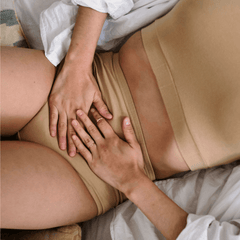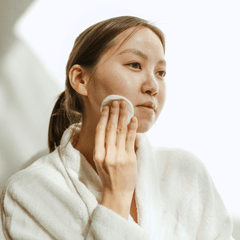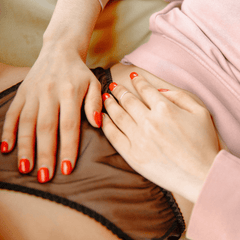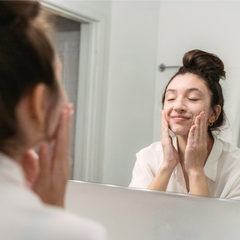The Biggest Hormonal Acne Triggers (and How to Fix Them)

Hormonal acne is one of the most frustrating skin concerns—especially when it feels like breakouts appear out of nowhere. If you’ve ever wondered why your skin suddenly flares up, you’re not alone. Understanding the biggest triggers for hormonal acne can help you take control of your skin and prevent future breakouts.
In this guide, we’ll break down the most common causes of hormonal acne, explain why they happen, and most importantly, give you actionable steps to rebalance your skin.
What Causes Hormonal Acne?
Hormonal acne is triggered by imbalances in sex hormones, particularly high androgens, which directly increase oil production. Estrogen and progesterone don’t stimulate oil production in the same way androgens do, but imbalances in these hormones do have an influence on androgen levels, thereby indirectly impacting oil production and skin health.
Some of the biggest triggers include:
-
Diet—certain foods can disrupt hormone balance, increasing oil production
-
Stress—raises cortisol, which again disrupts hormone balance, worsening breakouts
-
Chemicals—many everyday products and food items contain endocrine-disrupting chemicals (EDCs) that contribute to hormone imbalances and acne
-
Menstrual Cycle—hormone shifts throughout your period can worsen hormonal acne
-
Birth Control—stopping, starting, or switching methods can cause flare-ups
Let’s take a closer look at each trigger and what you can do about it.
1. Diet and Hormonal Acne: What Foods Cause Breakouts?
Your diet plays a crucial role in maintaining healthy skin. Certain foods can contribute to hormone imbalances, leading to acne, while others can help keep your skin clear.
Worst Foods for Hormonal Acne:
-
Non-Organic Animal Products – Most livestock are injected with hormones like estrogen to force growth and injected with antibiotics to avoid infection and illness. The problem is that when humans consume the meat or byproducts of these animals, they also consume the synthetic hormones and antibiotics. This can lead to estrogen overload and eventually estrogen dominance, a condition that causes an indirect increase in androgens, and a subsequent spike in oil production on the skin.
-
High-Glycemic Foods (sugar, white bread, pasta) – When consumed frequently, these types of foods can cause high blood sugar levels, which cause cells to become insensitive to the blood sugar regulating hormone, insulin. The body responds by producing more insulin. These high insulin levels increase androgen activity, boost sebum production, and cause hormonal acne on the surface of the skin.
-
Processed Foods – The more processed (less whole) a food, the less stable it is in the body, leading to issues like cell damage and inflammation. Most cooking oils (vegetable oil, canola oil) and packaged foods are not only highly processed, but often contain chemical additives that can be classified as endocrine-disrupting chemicals (EDCs). Furthermore, when consumed in large amounts, oil can contribute to the development of fat cells, which store and increase the production of estrogen.
Best Foods for Clear Skin:
-
Quality Protein (lean meats, eggs, legumes) – Protein is essential for hormone production and regulation. It plays a vital role in ensuring that our livers are functioning properly, which is crucial for processing excess hormones and toxins. That said, when choosing meat or dairy products, opt for organic as much as possible. This means the products come from animals that are given no antibiotics or growth hormones.
-
Fibre-Rich Foods (leafy greens, berries, flax, chia) – Fibrous foods are critical in supporting our hormone detoxification system. They help to ensure these used up hormones are properly eliminated from your body by not only by supporting overall gut health, but also binding to harmful hormones and toxins, reducing their absorption in the colon, and encouraging their excretion.
-
Healthy Fats (avocados, nuts, olive oil) – Your body needs fat to produce and synthesize certain hormones, and carry out certain functions, like uterus protection. These fats are also crucial for absorption of fat-soluble vitamins, like vitamins A, D, and E.
Making small changes to your diet can make a big difference, and removing one category at a time can help you better understand what's having the biggest impact on your skin.
2. Stress and Hormonal Acne: How Cortisol Affects Your Skin
Stress doesn’t just affect your mood—it affects your skin too. When you’re stressed, your body releases cortisol, a hormone that can:
-
Disrupt several other hormones—including progesterone, which is critical for managing levels of DHT, the primary acne-causing androgen.
-
Disrupt the gut microbiome—impacting what your body can and cannot absorb into the bloodstream.
-
Cause inflammation—triggering an immune response that can directly stimulate the sebaceous glands to produce more oil.
How to Lower Cortisol for Clearer Skin:
-
Prioritize Sleep – Aim for 7–9 hours per night. Lack of sleep causes your body to react as if it’s in distress, releasing more cortisol. Sleep helps calm and restore the body so that you’re better able to cope with stressful situations. Sleep also gives your body and skin the chance to heal and repair itself.
-
Practice Relaxation – Try breathwork, yoga, or meditation. The body responds to stress with muscle tension. At the same time, tense muscles tell the body that it’s stressed. Unless interrupted with a reminder or reason to relax, this positive feedback loop can continue indefinitely.
-
Exercise Regularly – Aim for 150 minutes of moderate aerobic activity or 75 minutes of vigorous aerobic activity each week. Physical activity produces endorphins and serotonin which elevate and stabilize your mood in a way that helps reduce stress. Physical activity can also help relieve physical stress caused by muscle tension.
If you’ve noticed more breakouts during stressful times, it could be your body’s way of telling you to slow down. Taking time to manage stress is a crucial step toward healthier skin.
3. Environmental Chemicals and Hormonal Acne: How Everyday Toxins Affect Your Skin
Endocrine-disrupting chemicals (EDCs) found in everyday products and food items are proven to interfere with hormone function, contributing to hormone imbalances and acne. While the impact of EDCs on hormones and skin may not be as immediate or obvious as diet and stress, with every day use, their effects can accumulate over time, potentially leading to chronic imbalances that make acne harder to manage.
Common Sources of EDCs:
-
Plastics (water bottles, food containers) – Plastics can leach harmful compounds like BPA and phthalates directly into food and beverages, especially when heated or exposed to acidic substances. These chemicals mimic estrogen and, since plastic exposure is so widespread in daily life, build up in the body, contributing to estrogen dominance and hormonal acne.
-
Personal Care and Cleaning Products (makeup, deodorants, air fresheners) – Because these products come into direct contact with your skin, and in some cases are inhaled (for example, with aerosol sprays), it’s easy for these harmful substances to absorb into your body. Ingredients like phthalates, parabens, and artificial fragrances are common offenders that mimic or disrupt hormones.
-
Pesticides and Artificial Additives - Pesticides and artificial additives are two major sources of EDCs that come through our food. Pesticides, used to protect crops from pests, can leave chemical residues on fruits, vegetables, and grains that are then ingested. Consuming food with artificial additives, including certain preservatives, colorings, and flavorings in processed foods, can also interfere with hormones.
-
Tap Water - Tap water is another unexpected source of EDCs. It can contain contaminants like pesticide residues, pharmaceuticals, and industrial chemicals that leach into water supplies and disrupt hormonal balance. Since we consume water daily, even low levels of exposure can accumulate over time and affect health.
How to Reduce Exposure:
-
Reduce your reliance on plastic bottles and containers by investing in glass or stainless steel alternatives.
-
Review and research the ingredients in all the personal care and cleaning products in your home, and eliminate those that contain harmful EDCs. Swap these products for clean alternatives, or make your own— vinegar, baking soda, and hydrogen peroxide is a great household cleaning alternative.
-
Choose organic or minimally processed foods when possible.
-
Although the majority of basic, plastic-free water filters cannot remove EDCs entirely, they can be effective at removing most contaminants as long as the filter is changed frequently.
4. Menstrual Cycle and Hormonal Acne: Why Breakouts Happen Before Your Period
Many people experience cyclical acne, with breakouts occurring at the same time each month. This happens because hormone levels fluctuate throughout the menstrual cycle, affecting oil production. A healthy, balanced body is designed to handle these hormonal changes without causing any issues, like breakouts. However, for many, these natural fluctuations can trigger acne—particularly when combined with other factors like poor diet, chronic stress, or underlying hormone imbalances. Ultimately, cyclical acne indicates that these normal, expected hormonal fluctuations are in some way amiss.
Hormonal Shifts That Cause Acne:
-
Before Your Period: The luteal phase (the two weeks before your period) is marked by high progesterone and relatively low estrogen. A healthy, balanced body should manage this hormonal change without issues, so breakouts during this phase could indicate a hormone imbalance, such as low progesterone or high estrogen—both signs of estrogen dominance, which can trigger hormonal acne.
-
During Ovulation: Testosterone levels are generally low and steady throughout the cycle, with a slight spike during ovulation. At the same time, estrogen rises to relatively high levels. Breakouts during this phase could indicate an imbalance of high testosterone or low estrogen, the latter being more common in women nearing menopause.
How to Reduce Period Breakouts:
-
For breakouts during the luteal phase, focus on supporting estrogen balance:
-
Consume plenty of of cruciferous veggies (broccoli, kale, cabbage, etc.), antioxidants (leafy greens, berries, nuts, etc.), fibre (flax, chia, beans, etc.), and water, all of which support estrogen detoxification.
-
For added estrogen detoxification support, take Balance daily—it’s the only supplement specifically designed to target hormonal acne caused by estrogen dominance, and works by helping your body metabolize and eliminate excess estrogens and other harmful toxins from the body.
-
For breakouts during ovulation, or other phases, focus on supporting testosterone balance:
-
Focus on balancing your blood sugar, as insulin spikes can lead to increased androgen production. Reduce your intake of refined sugars and unhealthy fats.
-
Consider anti-androgenic supplements like saw palmetto, or herbal teas like spearmint tea or stinging nettle root tea.
-
Adjusting your skincare routine based on your cycle can be helpful for some. For example, you might wash your face more frequently (no more than twice daily) as you approach your breakout phase.
5. Birth Control Pills and Hormonal Acne: How Contraceptives Affect Your Skin
Birth control can be both a solution and a trigger for hormonal acne. For some, it's an effective acne medication. For others, it tends to worsen the situation.
The pill is formulated with synthetic estrogen and progesterone (called progestin). By taking the pill each day, you’re increasing estrogen and progestin in your body, which suppresses other hormones like LH (luteinizing hormone), stopping ovulation and preventing androgen production in the ovaries. Since certain androgens are needed for sebum production, fewer androgens mean less sebum production, and less opportunity for clogged pores and acne.
Common Birth Control Changes That Trigger Acne:
-
Taking the Pill – Because of how the birth control pill works, it's often most effective for hormonal acne caused by high androgens. However, if the underlying issue is high estrogen, also known as estrogen dominance—a hormone imbalance that can drive up androgen levels—the pill may temporarily mask acne while exacerbating the root cause. This is because the synthetic estrogens in the pill add to already elevated levels of harmful estrogen. As a result, even if your skin clears, you may still experience symptoms of estrogen dominance, such as mood swings or headaches.
-
Stopping the Pill – Discontinuing the pill, especially after long-term use, is a major adjustment for your body. Since the pill suppresses natural hormone production, it can take time for your body to relearn how to regulate these hormones properly. In some cases, this can lead to lingering hormone deficiencies, creating the perfect environment for imbalances—and, in turn, acne. Additionally, if your breakouts were originally caused by estrogen dominance, the pill may have only masked your acne while worsening the imbalance. As a result, stopping the pill can trigger a surge in breakouts.
What to Do If Birth Control Changes Are Causing Acne:
-
If you're on the pill and experiencing acne or other symptoms:
-
-
Follow the tips in this article on diet, stress management, avoiding chemicals, and supporting estrogen balance.
-
Explore your hormonal health more deeply and consider switching to a different birth control method if needed.
-
-
If you've stopped taking the pill and are experiencing acne:
-
-
Be patient—your hormones may take a few months to fully regulate after stopping the pill.
-
Consider an estrogen-balancing supplement like Balance to help detoxify excess estrogen and ease your transition.
-
Summary: How to Prevent Hormonal Acne
Hormonal acne is complex, but once you identify your biggest triggers, you can take steps to rebalance your skin. Here’s a quick recap:
-
Make Diet Changes – Cut back on high-glycemic and processed foods, and focus on organic, whole foods, including quality protein, fibre, and healthy fats.
-
Manage Stress – Focus on lowering cortisol through improved sleep, relaxation, and exercise.
-
Reduce Toxins – Opt for clean formulas and plastic-free alternatives to reduce the impact of endocrine disruptors on your hormones and skin.
-
Track Your Cycle – Understand how breakouts during different phases can indicate hormone imbalances.
-
Be Mindful of Birth Control – Be aware of how birth control can affect your hormones and skin.
For a deeper dive into the different types of hormonal acne, check out this guide, or take our hormone imbalance quiz to uncover which hormone imbalances could be causing your breakouts.





